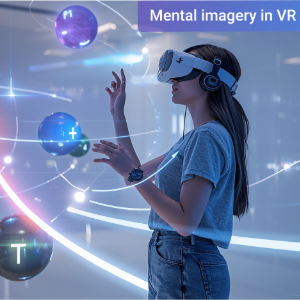Nidhi, a Master’s student in the School of Design and Creative Arts, developed a groundbreaking virtual reality (VR) platform that uses mental imagery scaffolding to help students conquer abstract STEM concepts like Coulomb's Law, transforming how they learn and retain complex information as her final year project. Nidhi's design will be demonstrated at the 2025 Postgraduate Showcase.
For my master’s project, I developed a virtual reality (VR) platform that helps students really get to grips with Coulomb's Law.
What makes a foundational concept, like Coulomb's Law particularly difficult for students to master and how can the simple act of doing help us to understand it?
Many of us struggle with abstract STEM concepts making it difficult to apply them to real-world challenges, potentially hindering technological and economic development.
Coulomb's Law seems to pose particular problems for many students but is a really important principle that underpins many modern technologies including smartphones and computer, air purification systems and medical equipment.
I've always been curious about how people understand and retain complex information. My research in this area led me to a theory called embodied cognition, our ability to learn by physically interacting with our environment. This approach offered an interesting framework for exploring the increasing role of VR within education and how it can enhance learning.
Virtual reality can be great for immersion, but can it really stick in the long run?
At the start of my project, a review of existing research revealed that although VR excellent scope for learning, its role in ensuring long-term retention and understanding is less well-documented.
So, I decided to investigate how a VR learning environment grounded in embodied cognition theory might help to improve students' long-term understanding of STEM concepts, like Coulomb's Law.
Before building the technology, how did you ensure students would actually adopt VR as a learning tool?
As well as my literature review, I conducted qualitative interviews with STEM students. Their feedback confirmed the feasibility of VR as a effective and acceptable learning tool.
So, I set to work creating my prototype VR platform. In fact, I created two versions. Both included three discrete phases:
- Onboarding
- Explanation: introducing Coulomb's Law's core principles using animations and video
- Interactive exploration: allowing users to manipulate virtual elements and observe changes in force and electric field
One, however, included prompts that encourage users to visualise their actions, effectively mentally rehearsing them before continuing the learning experience.
What was the most significant finding from your trials, and what does it suggest for future education research?
In my trials, the prompted version really helped users understand the concept of Coulomb’s Law. Although there wasn’t a huge difference between longer-term retention scores between the two versions, the guided technique remains promising.
It seems to make abstract concepts easier to learn and retain by combining interactive VR (IVR) with mental imagery scaffolding, a combination that’s not explored in STEM education research.
Beyond the VR platform itself, what was the most valuable lesson you learned about research design?
My project drew on everything I’ve learned over the years about research design helping me to plan my approach as well as properly evaluate and ensure the accuracy of my findings.
In addition, I picked up some completely new knowledge and skills, particularly around extended reality (XR) and coding. I learned how to use Unity, an XR toolkit, to develop my platform and leaned on ChatGPT as well as Gemini to generate my programming codes.
Where do you see this innovative intersection of VR and mental imagery taking your research next?
Perhaps most importantly, in terms of my career path, I’ve realised that I’d like to continue my research as a PhD student focusing on how my approach could be further developed and encouraging greater use of mental imagery across all VR learning environments.
Visit the School of Design and Creative Arts' Postgraduate Showcase to explore more designs like this.
